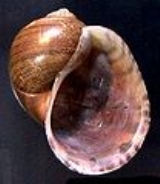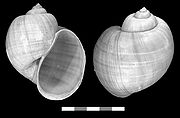
Pomacea haustrum
Encyclopedia
Pomacea haustrum, common name
the titan applesnail, is a species
of large freshwater snail
with an operculum
, an aquatic
gastropod mollusk in the family Ampullariidae, the applesnails.
in Conchologia Iconica in 1856.
Reeve's original text (the type description) reads as follows:
It is difficult to identify even the general region of the type locality for this species. The type locality was given as the Río Marañón, Brazil, but this river is in Peru, joining with the Rio Ucayali above Iquitos
to become the Rio Solimões, which in turn joins with the Rio Negro to become the Amazon River
of Brazil. Some of the first Europeans to explore the region in the sixteenth century
, however, referred to the Amazon River as El Río Marañón, and some nineteenth century maps refer to the entire Amazon as the Marañón. It is likely that the Río Marañón of one collector was not the same as the Río Marañón of another.
It was considered a synonym of Pomacea canaliculata
by Thompson (1997) based on shell morphology, but tentatively retained as a separate species by Cowie & Thiengo, because of its reported production of green eggs. Phylogenetic analyses by Rawlings et al. (2007) confirmed its species status.
 Pomacea haustrum is a large species that has a large globular shell
Pomacea haustrum is a large species that has a large globular shell
with a channeled suture.
, Brazil and Peru in South America.
The nonindigenous distribution includes the United States: Loxahatchee National Wildlife Refuge
waters in Palm Beach County, Florida. Pomacea haustrum were discovered in the late 1970s in Palm Beach County Florida, and have not spread appreciably in 30 years. This is the only known area where this species is established in the United States. The initial introduction in the United States was probably from aquarium release, aka "aquarium dumping". Pomacea haustrum is currently of relatively minor concern in the U.S., given its failure to spread beyond Palm Beach County after 30 years or more in Florida. However, many species have maintained limited distributions, sometimes for decades, before becoming invasive.
Common name
A common name of a taxon or organism is a name in general use within a community; it is often contrasted with the scientific name for the same organism...
the titan applesnail, is a species
Species
In biology, a species is one of the basic units of biological classification and a taxonomic rank. A species is often defined as a group of organisms capable of interbreeding and producing fertile offspring. While in many cases this definition is adequate, more precise or differing measures are...
of large freshwater snail
Freshwater snail
A freshwater snail is one kind of freshwater mollusc, the other kind being freshwater clams and mussels, i.e. freshwater bivalves. Specifically a freshwater snail is a gastropod that lives in a watery non-marine habitat. The majority of freshwater gastropods have a shell, with very few exceptions....
with an operculum
Operculum (gastropod)
The operculum, meaning little lid, is a corneous or calcareous anatomical structure which exists in many groups of sea snails and freshwater snails, and also in a few groups of land snails...
, an aquatic
Aquatic animal
An aquatic animal is an animal, either vertebrate or invertebrate, which lives in water for most or all of its life. It may breathe air or extract its oxygen from that dissolved in water through specialised organs called gills, or directly through its skin. Natural environments and the animals that...
gastropod mollusk in the family Ampullariidae, the applesnails.
Original description
Pomacea haustrum was originally described under name Ampullaria haustrum by Lovell Augustus ReeveLovell Augustus Reeve
Lovell Augustus Reeve was an English conchologist.Lovell Augustus Reeve was initially apprenticed to a grocer of Ludgate Hill between 1827 and '34...
in Conchologia Iconica in 1856.
Reeve's original text (the type description) reads as follows:
It is difficult to identify even the general region of the type locality for this species. The type locality was given as the Río Marañón, Brazil, but this river is in Peru, joining with the Rio Ucayali above Iquitos
Iquitos
Iquitos is the largest city in the Peruvian rainforest, with a population of 370,962. It is the capital of Loreto Region and Maynas Province.Located on the Amazon River, it is only above sea level, although it is more than from the mouth of the Amazon at Belém on the Atlantic Ocean...
to become the Rio Solimões, which in turn joins with the Rio Negro to become the Amazon River
Amazon River
The Amazon of South America is the second longest river in the world and by far the largest by waterflow with an average discharge greater than the next seven largest rivers combined...
of Brazil. Some of the first Europeans to explore the region in the sixteenth century
Colonial Brazil
In the history of Brazil, Colonial Brazil, officially the Viceroyalty of Brazil comprises the period from 1500, with the arrival of the Portuguese, until 1815, when Brazil was elevated to kingdom alongside Portugal as the United Kingdom of Portugal, Brazil and the Algarves.During the over 300 years...
, however, referred to the Amazon River as El Río Marañón, and some nineteenth century maps refer to the entire Amazon as the Marañón. It is likely that the Río Marañón of one collector was not the same as the Río Marañón of another.
It was considered a synonym of Pomacea canaliculata
Pomacea canaliculata
Pomacea canaliculata, common name the channeled applesnail, is a species of large freshwater snail with gills and an operculum, an aquatic gastropod mollusk in the family Ampullariidae, the apple snails....
by Thompson (1997) based on shell morphology, but tentatively retained as a separate species by Cowie & Thiengo, because of its reported production of green eggs. Phylogenetic analyses by Rawlings et al. (2007) confirmed its species status.
Shell description

Gastropod shell
The gastropod shell is a shell which is part of the body of a gastropod or snail, one kind of mollusc. The gastropod shell is an external skeleton or exoskeleton, which serves not only for muscle attachment, but also for protection from predators and from mechanical damage...
with a channeled suture.
Distribution
The indigenous distribution of Pomacea haustrum is BoliviaBolivia
Bolivia officially known as Plurinational State of Bolivia , is a landlocked country in central South America. It is the poorest country in South America...
, Brazil and Peru in South America.
The nonindigenous distribution includes the United States: Loxahatchee National Wildlife Refuge
Loxahatchee National Wildlife Refuge
The 147,392 acre Arthur R. Marshall Loxahatchee National Wildlife Refuge includes the most northern remnant of the historic Everglades wetland ecosystem...
waters in Palm Beach County, Florida. Pomacea haustrum were discovered in the late 1970s in Palm Beach County Florida, and have not spread appreciably in 30 years. This is the only known area where this species is established in the United States. The initial introduction in the United States was probably from aquarium release, aka "aquarium dumping". Pomacea haustrum is currently of relatively minor concern in the U.S., given its failure to spread beyond Palm Beach County after 30 years or more in Florida. However, many species have maintained limited distributions, sometimes for decades, before becoming invasive.
Life cycle
Populations of Pomacea haustrum in Florida produce bright green egg masses consisting of individual eggs approximately 3–5 mm in size compressed into polygonal shapes, giving the egg mass an irregular honeycombed appearance. Since other Pomacea species also produce green eggs, this character is insufficient to verify this species as Pomacea haustrum. It lays its eggs in clutches above the water level.Further reading
Milward-de Andrade R. & Carvalho O. S. (1979). "[Colonization of Pomacea haustrum (Reeve 1856) in a schistosomiasis mansoni locality: Baldim, MG (Brazil). (Prosobranchia, Pilidae)]". Rev Saude Publica 13(2): 92-107.- Ghesquiere S. Pomacea (Pomacea) haustrum. The Apple Snail (Ampullariidae) Website http://www.applesnail.net
- Applesnails of Florida on the UFUniversity of FloridaThe University of Florida is an American public land-grant, sea-grant, and space-grant research university located on a campus in Gainesville, Florida. The university traces its historical origins to 1853, and has operated continuously on its present Gainesville campus since September 1906...
/ IFASInstitute of Food and Agricultural SciencesThe University of Florida’s Institute of Food and Agricultural Sciences is a federal-state-county partnership dedicated to developing knowledge in agriculture, human and natural resources, and the life sciences, and enhancing and sustaining the quality of human life by making that information...
Featured Creatures Web site

